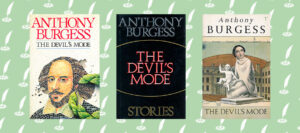Burgess on detective fiction
-
Andrew Biswell
- 21st November 2024
-
category
- Blog Posts
In which our author hunts for the Moonstone and rewrites Sherlock Holmes.

Although Anthony Burgess is often thought of as an upmarket literary writer, he was deeply engaged throughout his writing life with popular forms of writing. Beyond his involvement in writing historical fiction, science fiction, and Cold War spy novels, he had a serious interest in detective fiction.
Burgess’s book collection includes popular detective stories by authors such as Dorothy L. Sayers, Raymond Chandler, Agatha Christie and G.K. Chesterton. His enthusiasm and knowledge of the subject are clearly signalled in his introduction to a paperback reprint of The Moonstone by Wilkie Collins, published by Pan in 1967. Burgess identifies Collins (1824-89) as a great innovator of literary form — and, in particular, as the originator of the modern detective novel.
First published in serial form in 1868, The Moonstone is an exciting and often melodramatic story about a valuable Indian diamond, which is stolen during a house party in rural England. Suspicion falls on three Indian jugglers who have been seen in the neighbourhood — and the figure of the police investigator, Sergeant Cuff, anticipates many of the fictional detectives who appeared in later crime novels.
Burgess admired Wilkie Collins as an expert craftsman who put character at the heart of his novels and was ‘one of the finest Victorian portrayers of women.’ The novel’s heroine, Rachel Verrinder, is described by Burgess as ‘a whole personality […] intelligent, strong-minded, sure of herself.’ Although Collins’s style is said to be less florid than that of Charles Dickens, his friend and publisher, The Moonstone is judged to be an undoubted milestone in the history of the novel. Burgess says that the literary powers of its author are ‘wide enough for any major novelist.’
‘The wonder of Collins’s book,’ he concludes, ‘is that all the excellences of the genre are already there, fully developed. He is an old master who shows no signs of age.’
Given Burgess’s strong interest in detective fiction, readers of The Devil’s Mode — the only collection of his short stories to be published in his lifetime — should not have been surprised to find a Sherlock Holmes story, ‘Murder to Music’, at the end of the book.
Burgess’s extravagant plot involves Holmes and Watson thwarting a sinister plot to assassinate the King of Spain while he is visiting London. The story hinges on a secret musical code which is communicated by a concert violinist during a performance. As is often the case with Burgess, music turns out to be at the heart of the matter, and it is the key to the mystery. Burgess’s Sherlock Holmes story has been included in anthologies of post-Conan Doyle Sherlockian fiction, and it has recently been published in an illustrated bilingual English-Spanish edition.
Burgess returns to Sherlock Holmes in one of his literary essays collected in One Man’s Chorus, edited by Ben Forkner. Written in 1988 to mark the 100th anniversary of A Study in Scarlet (the first Sherlock Holmes story), the essay, titled ‘Our Eternal Holmes’, shows a detailed knowledge of the Conan Doyle canon. Burgess notes that the fictional Sherlock Holmes was educated by the Jesuits at Stonyhurst Abbey, which informs his approach to solving cases: ‘He has an absolute moral sense, a Jesuitical awareness of the boundaries of good and evil, but, though he seems to have no sex life, he is dissolute enough to merit the love we reserve to imperfection.’ Holmes, the prolific smoker and drug addict, appealed to Burgess because he was untidy and played the violin ‘probably not very well.’ As Burgess says, Holmes has an almost universal appeal because he was clearly ‘an outsider.’
He goes on to claim that, like Don Quixote and Shakespeare’s Falstaff, the character of Sherlock Holmes was deep and rich enough to make him one of the fictional immortals: ‘He can never die because he never lived.’
It’s clear that Burgess’s enthusiasm for Sherlock Holmes sequels extended beyond his own writing. In 1983 the Observer asked him to review Umberto Eco’s first novel, The Name of the Rose, a detective novel set in a medieval Benedictine monastery. Reading the translation by William Weaver, Burgess immediately noticed that the main character in the novel, William of Baskerville, shares many characteristics with the protagonist of Conan Doyle’s stories, and that Adso, the book’s first-person narrator, is a medieval version of Doctor Watson. Of course the anachronisms are part of Eco’s postmodern style, but above all Burgess admired the deep research and hyper-realism which stand behind the novel. He wrote: ‘Read this book and you will never again have to wonder how an Italian monastery functioned in the fourteenth century.’
Summing up The Name of the Rose, Burgess said: ‘So we seem to have a kind of joke, the transplantation of the sleuth of Baker Street to medieval Italy […] Theology and criminal detection go, for some reason, well together.’ He compared The Name of the Rose to works of classic detective fiction by G.K. Chesterton and Dorothy L. Sayers. He concluded: ‘As a somewhat elongated thriller it is far far far better than anything by the late Dame Agatha Christie.’
As a novelist and critic, Burgess was always interested in genre fiction, and the ways in which its devices could be redeployed to refresh and extend the possibilities of the form. No doubt he would have followed recent developments with close attention, and responded to them in his own fiction.


